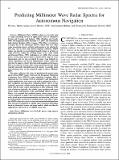| dc.contributor.author | Jose, Ebi | |
| dc.contributor.author | Adams, Martin | |
| dc.contributor.author | Mullane, John Stephen | |
| dc.contributor.author | Patrikalakis, Nicholas M. | |
| dc.date.accessioned | 2013-06-17T14:17:09Z | |
| dc.date.available | 2013-06-17T14:17:09Z | |
| dc.date.issued | 2010-03 | |
| dc.date.submitted | 2009-10 | |
| dc.identifier.issn | 1530-437X | |
| dc.identifier.issn | 1558-1748 | |
| dc.identifier.uri | http://hdl.handle.net/1721.1/79120 | |
| dc.description.abstract | Millimeter Wave (MMW) radars are currently used as range measuring devices in applications such as automotive driving aids (Langer and Jochem, 1996), (Rohling and Mende, 1996), the mapping of mines (Brooker et al., 2005) and autonomous field robotics (Brooker, 2001), (Langer, 1996). This recent interest is largely due to the advantages MMW radars offer over other range measuring sensors, as their performance is less affected by dust, fog, rain or snow and ambient lighting conditions. MMW radars can provide received signal strength values, at all discrete range intervals, within the working range of the radar (Clark and Durrant-Whyte, 1997), (Scheding et al., 2002). The received power versus range spectra hence contain useful range to target information, but are also corrupted by noise. User defined stochastic algorithms can then be implemented, which exploit this rich data to improve object detection and mapping performance. This is in contrast to many other range measuring devices which typically internally threshold received signals, to provide single hard decisions only, on the estimated range to objects (Mullane, 2007). This paper addresses the issues of predicting the power-range spectra from MMW radars which use the Frequency Modulated Continuous Wave (FMCW) range estimation technique. This is important for two reasons. First, in automotive and autonomous robotic applications, such sensors are used in conjunction with vehicle navigation and map state estimation filters. This is so that (typically uncertain) vehicle motion knowledge can be optimally fused with the noisy sensor information, to infer estimates of the state of interest (typically, the vehicle's pose (position and orientation) and/or information of the surrounding object locations). Hence, it is essential that predicted power versus range spectra can be computed, to apply a Bayesian recursive estimation framework, based on previous measurements, and uncertain vehicle motion information. Second, it- is extremely useful to be able to simulate MMW radar data, given certain environmental configurations. This aids the development of reliable object detection algorithms, based on theoretical sensor and noise models, which can then be applied more effectively to real MMW radar data. | en_US |
| dc.description.sponsorship | Singapore-MIT Alliance for Research and Technology. Center for Environmental Sensing and Monitoring | en_US |
| dc.language.iso | en_US | |
| dc.publisher | Institute of Electrical and Electronics Engineers (IEEE) | en_US |
| dc.relation.isversionof | http://dx.doi.org/10.1109/jsen.2009.2037013 | en_US |
| dc.rights | Article is made available in accordance with the publisher's policy and may be subject to US copyright law. Please refer to the publisher's site for terms of use. | en_US |
| dc.source | IEEE | en_US |
| dc.title | Predicting Millimeter Wave Radar Spectra for Autonomous Navigation | en_US |
| dc.type | Article | en_US |
| dc.identifier.citation | Jose, Ebi, Martin Adams, John Stephen Mullane, and Nicholas M. Patrikalakis. Predicting Millimeter Wave Radar Spectra for Autonomous Navigation. IEEE Sensors Journal 10, no. 5 (May 2010): 960-971. © 2010 IEEE | en_US |
| dc.contributor.department | Massachusetts Institute of Technology. Department of Mechanical Engineering | en_US |
| dc.contributor.mitauthor | Patrikalakis, Nicholas M. | en_US |
| dc.relation.journal | IEEE Sensors Journal | en_US |
| dc.eprint.version | Final published version | en_US |
| dc.type.uri | http://purl.org/eprint/type/JournalArticle | en_US |
| eprint.status | http://purl.org/eprint/status/PeerReviewed | en_US |
| dspace.orderedauthors | Jose, Ebi; Adams, Martin; Mullane, John Stephen; Patrikalakis, Nicholas M. | en_US |
| mit.license | PUBLISHER_POLICY | en_US |
| mit.metadata.status | Complete | |
